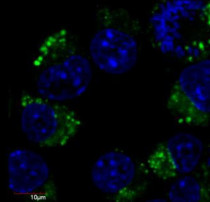ARG53750
anti-beta III Tubulin antibody [TU-20] (FITC)
anti-beta III Tubulin antibody [TU-20] (FITC) for ICC/IF and Human,Mouse,Rat,Dog,Pig
Controls and Markers antibody; Neuroscience antibody; Signaling Transduction antibody; Neuron Development Study antibody; Neuronal Cytoskeletal antibody; Neurite Marker antibody
Overview
| Product Description | FITC-conjugated Mouse Monoclonal antibody [TU-20] recognizes beta III Tubulin |
|---|---|
| Tested Reactivity | Hu, Ms, Rat, Dog, Pig |
| Tested Application | ICC/IF |
| Specificity | The clone TU-20 recognizes C-terminal peptide sequence ESESQGPK (aa 441-448) of neuron-specific human beta III Tubulin. |
| Host | Mouse |
| Clonality | Monoclonal |
| Clone | TU-20 |
| Isotype | IgG1 |
| Target Name | beta III Tubulin |
| Immunogen | Peptide (C) 441-448 coupled to maleimide-activated keyhole limpet hemocyanin via cysteine added to the N-terminus of the neuron-specific peptide. |
| Conjugation | FITC |
| Alternate Names | CDCBM1; Tubulin beta-4 chain; Tubulin beta-3 chain; CFEOM3A; Tubulin beta-III; TUBB4; CDCBM; CFEOM3; FEOM3; beta-4 |
Application Instructions
| Application Suggestion |
|
||||
|---|---|---|---|---|---|
| Application Note | * The dilutions indicate recommended starting dilutions and the optimal dilutions or concentrations should be determined by the scientist. |
Properties
| Form | Liquid |
|---|---|
| Purification Note | The purified antibody is conjugated with Fluorescein isothiocyanate (FITC) under optimum conditions. The reagent is free of unconjugated FITC. |
| Buffer | PBS (pH 7.4) and 15 mM Sodium azide |
| Preservative | 15 mM Sodium azide |
| Concentration | 1 mg/ml |
| Storage Instruction | Aliquot and store in the dark at 2-8°C. Keep protected from prolonged exposure to light. Avoid repeated freeze/thaw cycles. Suggest spin the vial prior to opening. The antibody solution should be gently mixed before use. |
| Note | For laboratory research only, not for drug, diagnostic or other use. |
Bioinformation
| Database Links | |
|---|---|
| Gene Symbol | TUBB3 |
| Gene Full Name | tubulin, beta 3 class III |
| Background | The betaIII-Tubulin isoform is present dominantly in cells of neuronal origin and it is one of the earliest markers of neuronal differentiation. It is regarded as a specific probe for the cells of neuronal origin as well as for the tumours originating from these cells. The betaIII-Tubulin is most abundant in cells of neuronal origin, but was also detected in Sertoli cells of the testis and transiently in non-neuronal embryonic tissues. |
| Function | Tubulin is the major constituent of microtubules. It binds two moles of GTP, one at an exchangeable site on the beta chain and one at a non-exchangeable site on the alpha chain. TUBB3 plays a critical role in proper axon guidance and mantainance. [UniProt] |
| Highlight | Related products: beta III Tubulin antibodies; beta III Tubulin Duos / Panels; Anti-Mouse IgG secondary antibodies; Related news: Astrocyte-to-neuron conversion for Parkinson's disease treatment |
| Research Area | Controls and Markers antibody; Neuroscience antibody; Signaling Transduction antibody; Neuron Development Study antibody; Neuronal Cytoskeletal antibody; Neurite Marker antibody |
| Calculated MW | 50 kDa |
| PTM | Some glutamate residues at the C-terminus are polyglutamylated, resulting in polyglutamate chains on the gamma-carboxyl group (PubMed:26875866). Polyglutamylation plays a key role in microtubule severing by spastin (SPAST). SPAST preferentially recognizes and acts on microtubules decorated with short polyglutamate tails: severing activity by SPAST increases as the number of glutamates per tubulin rises from one to eight, but decreases beyond this glutamylation threshold (PubMed:26875866). Some glutamate residues at the C-terminus are monoglycylated but not polyglycylated due to the absence of functional TTLL10 in human. Monoglycylation is mainly limited to tubulin incorporated into axonemes (cilia and flagella). Both polyglutamylation and monoglycylation can coexist on the same protein on adjacent residues, and lowering glycylation levels increases polyglutamylation, and reciprocally. The precise function of monoglycylation is still unclear (Probable). Phosphorylated on Ser-172 by CDK1 during the cell cycle, from metaphase to telophase, but not in interphase. This phosphorylation inhibits tubulin incorporation into microtubules. |
Images (1) Click the Picture to Zoom In
Clone References








